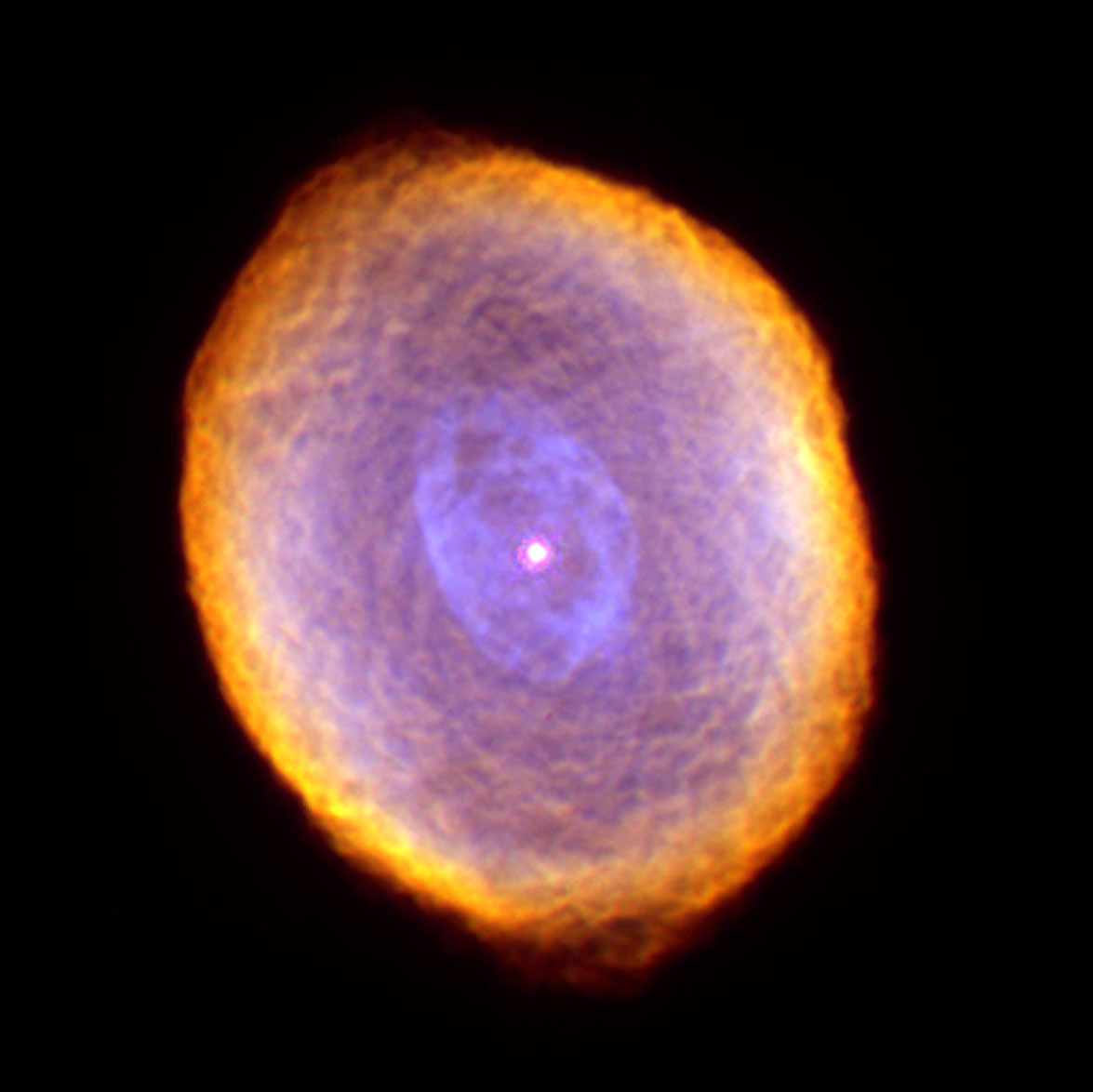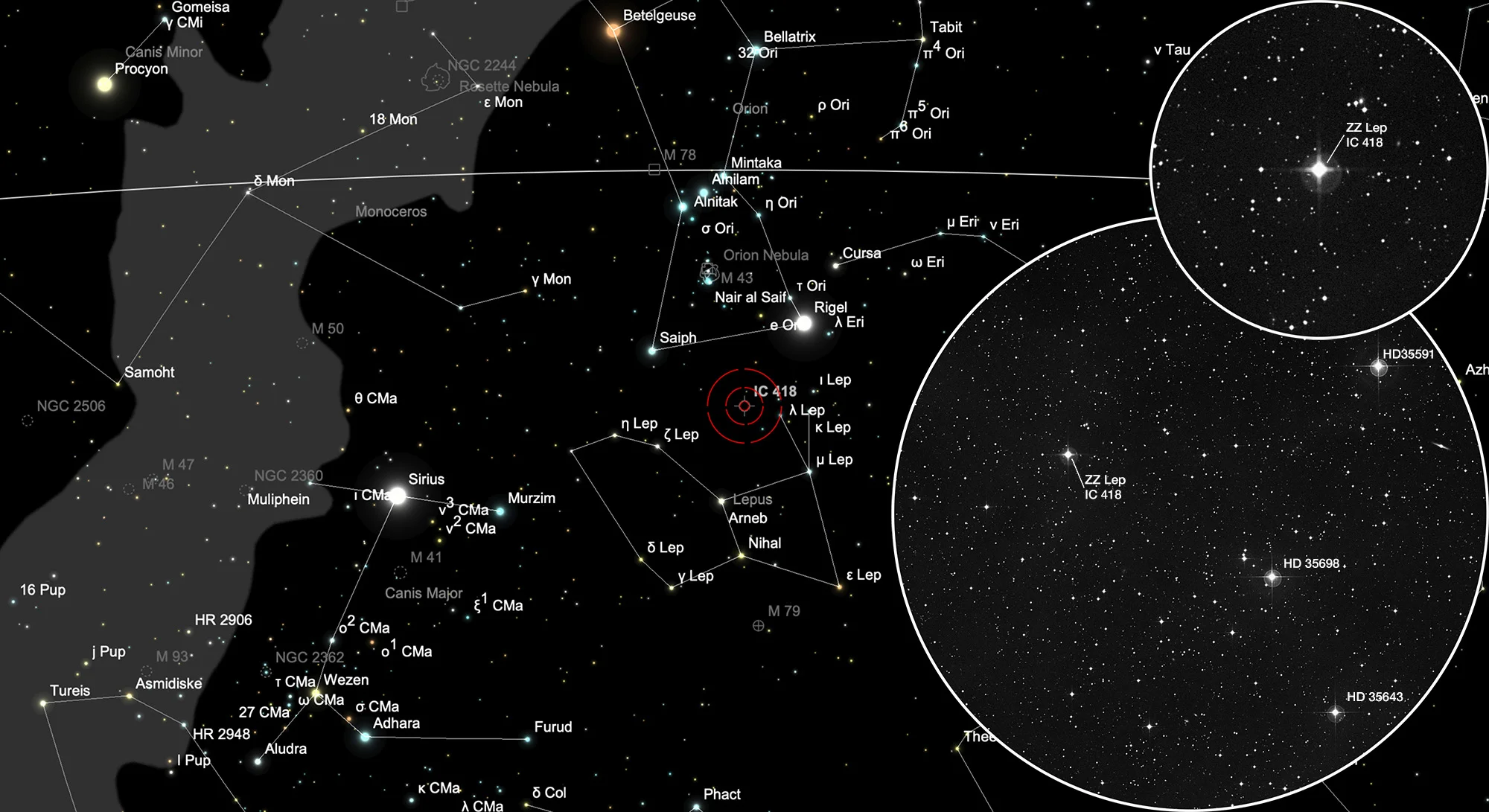Spirograph Nebula (IC 418)


History
This planetary nebula was discovered on 26 March 1891 by Williamina Fleming, a Scottish-American astronomer. She worked for Edward Pickering to whom John L. E. Dreyer mistakenly credited the discovery in his «Index Catalogue» appeared in 1895. [314]
Physical Properties
IC 418 is a planetary nebula with a high-density ellipsoidal shell, which overall morphology looks simple. A detailed view of the Hubble Space Telescope has revealed an intricate cyclic pattern that has given the «Spirograph Nebula». Magnetic fields or variable stellar wind could be responsible for these patterns. The central star has a relatively low effective temperature of 39'000 K and is in an early evolutionary stage. The distance is measured to 1.3 ± 0.4 kpc. [541]
| Designations | PN G215.2-24.2: IC 418, PK 215-24.1, ARO 3, VV 22, VV' 32 |
| Right Ascension (J2000.0) | 05h 27m 28s |
| Declination (J2000.0) | -12° 41' 48" |
| Dimensions | 12." (optical) |
| Distance | 0.88 kpc |
| Radial Velocity | +61.0 ± 2.0 km/s |
| Expansion Velocity | < 6.0 (O-III) 12. (N-II) km/s |
| C-Star Designations | AG82 43, BD -12 1172, EM* CDS 500, GCRV 3288, HD 35914, PLX 1239, TD1 4662 |
| C-Star Magnitude | B: 10.00, V: 10.17 |
| C-Star Spectral Type | Of(H) |
| Discoverer | FLEMING 1891 |
Finder Chart
The 10 mag star ZZ Leporis with the planetary nebula IC 418 is located near the ears of the Hare (Lepus), south of Orion. Together with three other stars of about 7 mag it forms a conspicuous figure that can be seen in an eyepiece which gives approximately 1° true field of view. On 15 December it is in opposition to the Sun and crosses the meridian at local midnight. The best time to observe it is August to May.
Visual Observation
400 mm Aperture: In the 9 mm Nagler eyepiece, IC 418 displays a bright central star surrounded by a small, round nebula. When switching from indirect to direct view, the nebula fades slightly, revealing only the central star. Whether the edge is somewhat brighter or if it's a contrast effect with the central star is not definitively clear. — 400 mm f/4.5 Taurus Dobsonian, Hasliberg, 16. 12. 2023, SQM 21.2, Bernd Nies
635 mm Aperture: At low magnification (35 mm Tele Vue Panoptic, 72x), the small planetary nebula (PN) can be distinguished from the other three stars in the neighborhood by a slightly larger disk. With this small, bright object, it's worth increasing the magnification significantly. Its diameter is only 12 arcseconds. It reveals itself as a bright ring with a fainter inner region and a bright central star. A beautiful sight. However, the Spirograph-like structure is not discernible. — 25" f/4 Obession Dobsonian, Astrofarm Tivoli, Namibia, 16. 9. 2023, Bernd Nies
762 mm Aperture: The Spirograph Nebula IC 418 appeared, as expected, as an extended faint oval, resembling a slightly out-of-focus star. The bright central star is difficult to distinguish from the only slightly dimmer inner region. In the single EAA image as well as in the stacked EAA image, the central star is hardly separable from the nebula. – 30" SlipStream-Dobson f/3.3, Hasliberg, 30. 11. 2024, SQM-L 21.04, Eduard von Bergen
